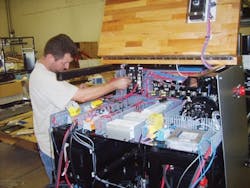AGVs Won't Hit the Wall
Although Disney uses automatic guided vehicle system (AGVS) technology to help it create a horrifying thrill ride in its Tower of Terror, the mobile robots are actually nothing if not safe. Unlike typical robots that operate behind a safety fence, AGVs require a whole different set of standards to travel across a factory floor where people walk, notes Tommy Hessler, CEO of America in Motion (AIM, www.weareaim.com), a company that provides AGVS products from its headquarters in Charlotte, North Carolina.
A typical AGV from AIM includes a safety relay and several Class 3 laser safety scanners and Hessler says the AGVs meet the ANSI 56.6 standard, and are safe for operation indoors as well as outdoors.
But the technology is still not used to a great extent, with only about 4,000 AGVs sold each year, worldwide, according to Hessler. In the U.S., that market is some 500-600 vehicles. The potential for cost savings is significant. A three-shift operation can justify the cost of the system in as little as a year, Hessler says.
Another terror often associated with AGVS is the idea that American jobs are eliminated by automating the transportation flow of materials and products to and from various production processes. "In fact the opposite is actually true," Hessler contends. The whole idea behind the name of the company, in fact, was that the founders "wanted to put American back into motion," he says. Manufacturers were sending jobs overseas to capture lower labor costs. To compete in the U.S., Hessler says, "you can halve your salary, which nobody wants, or you can automate."
Hessler started AIM in 2007 after almost 25 years in the AGVS business, beginning in Sweden, where the technology got its start. The first major AGVS application came about in the early '70s, when Volvo put out an RFQ for a new automotive plant, Hessler says. They wanted a way to move platforms to the cars being built. NDC AB in Sweden, which Hessler worked for in later years, won the order for 260 AGVs with technology it had originally developed in 1962—making it the first huge showcase for the technology.
AIM is a small company of about 20 employees, just about all of whom are engineers with a mix of skills in mechanical, electrical and software design, Hessler says. "We use Beckhoff PLCs with more specialized AGVS controls from Kollmorgen," he says. "This is for onboard each AGV, as well as the system control side where all call stations and load monitoring is done by a soft PLC Beckhoff system."
Battery technology and charging algorithms are a particular selling point for AIM, Hessler adds, noting that many of the industry's offerings are noisy, dirty, diesel-operated vehicles. Others that are battery-operated run for eight hours, and then the battery must be manually removed and recharged. A typical AGV from AIM will run for about an hour, plug itself into the wall to charge for 5-10 minutes, and then be off and running again on its own.
AIM supports its customers remotely through Internet access to the system. "We are able to diagnose any problems, and even make changes to the system if a customer so desires without having to travel to site," Hessler says. The people on the plant floor love this because problems are solved quickly, he says. As might be expected, IT typically has to have its security concerns addressed, but there hasn't been a single security incident to compound concerns, he notes.
AGVS makes considerable use of wireless technology, since this is how the AGV communicates with the system. "We have also reduced installation costs a lot by using wireless between hard-wired PLC control systems used on conveyors and stretch wrappers throughout a whole facility," Hessler adds.


